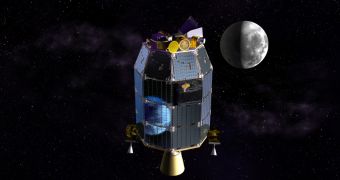Officials at NASA have just announced that they plan to extend the mission of the Lunar Atmosphere and Dust Environment Explorer (LADEE) by an additional 28 days. This was made possible by very accurate engine burns, which left more fuel in the spacecraft's tanks than originally estimated.
At the end of its science mission, the vehicle is scheduled to drop towards and impact the lunar surface, generating a massive plume of smoke as it does so. However, it is now possible to conduct an additional full lunar cycle, enabling the collection of even more science data from low altitudes.
According to the announcement that NASA made, LADEE is now scheduled to impact the lunar surface on or around April 21, 2014. The exact date cannot be set at this point, due to uncertainties related to the spacecraft's final trajectory in the last days of its mission.
The satellite was designed, built and tested at the NASA Ames Research Center (ARC), in Moffett Field, California. It was launched into space on September 6, 2013 aboard a Minotaur V rocket, from the NASA Wallops Flight Facility, on Wallops Island, Virginia.
The probe successfully achieved orbital insertion around Earth's natural satellite on October 6, and began its science mission on November 10. Within 10 days, the spacecraft descended to its current orbit, a mere 12 to 60 kilometers (8 to 37 miles) above the lunar surface.
This unique type of orbit enables LADEE to pass frequently from lunar day to lunar night, which in turn makes it possible for it to analyze the tenuous exosphere surrounding the Moon in great detail.
“The launch vehicle performance and orbit capture burns using LADEE's onboard engines were extremely accurate, so the spacecraft had significant propellant remaining to enable extra science,” explains ARC LADEE Project Manager, Butler Hine.
“This extension represents a tremendous increase in the amount of science data returned from the mission,” adds the expert. “The science team has already established a baseline of data for the tenuous lunar atmosphere, or exosphere, and dust impacts,” says ARC project scientist Rick Elphic.
The mission extension will enable LADEE to fly at extremely low altitudes for a short period, marking the first time science data have been collected so close to the lunar surface in nearly half a century of space exploration.

 14 DAY TRIAL //
14 DAY TRIAL //